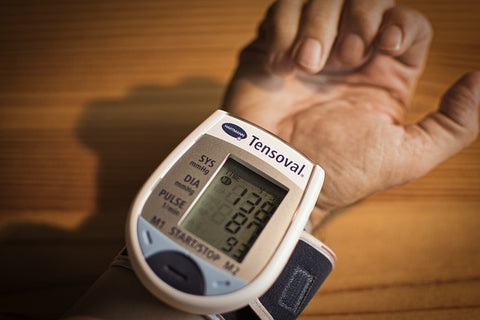
Hypertension (high blood pressure) is when the pressure in your blood vessels is too high (140/90 mmHg or higher). It is common but can be serious if not treated.People with high blood pressure may not feel symptoms. The only way to know is to get your blood pressure checked.
Things that increase the risk of having high blood pressure include:
- Old Age
- Genetics
- Obesity
- Sedentary or Lack of Physical Activity
- High-Salt Diet
- Excessive consumption of alcohol
Lifestyle changes such as daily exercise, quitting smoking and eating healthy could help lower blood pressure for some. There are a few that really need certain medication to fight it.
Blood pressure is written as two numbers. The first (systolic) number represents the pressure in blood vessels when the heart contracts or beats. The second (diastolic) number represents the pressure in the vessels when the heart rests between beats.
Hypertension is diagnosed if, when it is measured on two different days, the systolic blood pressure readings on both days is ≥140 mmHg and/or the diastolic blood pressure readings on both days is ≥90 mmHg.
The American College of Cardiology and the American Heart Association divide blood pressure into four general categories. Ideal blood pressure is categorized as normal.
- Normal blood pressure. Blood pressure is lower than 120/80 mm Hg.
- Elevated blood pressure. The top number ranges from 120 to 129 mm Hg and the bottom number is below, not above, 80 mm Hg.
- Stage 1 hypertension. The top number ranges from 130 to 139 mm Hg or the bottom number is between 80 and 89 mm Hg.
- Stage 2 hypertension. The top number is 140 mm Hg or higher or the bottom number is 90 mm Hg or higher.
Blood pressure higher than 180/120 mm Hg is considered a hypertensive emergency or crisis. Seek emergency medical help for anyone with these blood pressure numbers.
Untreated, high blood pressure increases the risk of heart attack, stroke and other serious health problems. It's important to have your blood pressure checked at least every two years starting at age 18. Some people need more-frequent checks.
Healthy lifestyle habits —such as not smoking, exercising and eating well — can help prevent and treat high blood pressure. Some people need medicine to treat high blood pressure.
Dietary Patterns for Hypertension
DASH Diet
One of the most well-known dietary strategies for lowering blood pressure is the Dietary Approaches to Stop Hypertension (DASH) pattern , which significantly reduced blood pressure among normotensives as well as those with hypertension. The DASH dietary pattern, which emphasizes a diet rich in fruits, vegetables, and low-fat dairy products and reduced saturated and total fat, has been tested in multiple randomized controlled trials in specific populations including obese hypertensives and individuals with type 2 diabetes, both alone and in combination with other lifestyle interventions with consistent results. The Optimal Macronutrient Intake to Prevent Heart Disease (OmniHeart) trial demonstrated that within a DASH-like dietary pattern, substituting protein for carbohydrate or substituting fat (primarily monounsaturated) for carbohydrate additionally lowered blood pressure.
Mediterranean Diet
The Mediterranean dietary pattern has many similarities with the DASH dietary pattern but is generally higher in fat, primarily monounsaturated fat from olive oil, nuts, and seeds (commonly close to 40 % of daily energy).
Macronutrients
Manipulations of macronutrients, including protein, fat, and carbohydrates, have been a cornerstone of strategies for weight loss and improving the cholesterol profile for many years. The evidence that particular macronutrients are also effective in reducing blood pressure is quite strong. The largest body of evidence for any macronutrients’ influence on blood pressure is that regarding protein.
Protein
A variety of studies, both observational and randomized controlled trials, have demonstrated that protein supplementation or the replacement of protein for fat or carbohydrate in an isocaloric diet results in lower blood pressures.
Fats
Given the long history of the diet-heart hypothesis, dietary fats have also been a focus of investigation in the area of hypertension and blood pressure. Total dietary fat intake includes intakes of saturated, omega-3 polyunsaturated, omega-6 poly-unsaturated, and monounsaturated fatty acids.
Exercise Essential for Hypertension
Exercise and mechanism of BP lowering
Acute physiologic response to exercise: Aerobic exercise increases and redistributes cardiac output to maintain perfusion of active muscles. This response is triggered by neurohormonal and hydrostatic mechanisms, initially by increasing systolic volume and then by increasing the heart rate. Systolic BP rises as cardiac output increases, while DBP falls as a result of decreased peripheral vascular resistance (PVR), facilitating perfusion of large muscle groups.
Post Exercise physiological response: A hypotensive response lasting up to 22 hours after exercise is caused by reduced norepinephrine levels and thus by inhibition of sympathetic activity and reduction in circulating angiotensin II, adenosine, and endothelin levels and their receptors in the central nervous system, leading to decreased PVR and increased baroreflex sensitivity. Hypotension is also triggered by the vasodilator effect of prostaglandins and nitric oxide.
Aerobic exercise and hypertension
Aerobic exercise, when not contraindicated, is almost completely free of secondary effects. This type of exercise consists of regular, purposeful movement of joints and large muscle groups. Regular aerobic exercise has been shown to reduce resting BP and BP reactivity to stressors. Examples of aerobic exercise include speed walking, jogging, running, dancing, cycling, and swimming.
Dynamic resistance exercise and hypertension
In dynamic resistance training, effort is performed against an opposing force accompanied by purposeful movement of joints and large muscle groups with a goal of progressively increasing muscle strength. It involves concentric or eccentric contraction of muscles. Examples of dynamic resistance exercise are weight lifting and circuit training with equipment such as resistance-training machines.
Training regimens consist of 2 to 3 sessions per week of 8 to 10 weight-lifting exercises working the important muscle groups at a resistance (weight) of 30% to 40% of the 1-repetition maximum (ie, the heaviest weight that can be lifted once) for upper-body exercises and 50% to 60% of the 1-repetition maximum for lower-body exercises. Exercises should comprise 3 sets of 10 to 15 repetitions.
Conclusion:
Hypertension risk factors include genetic, age, environment and diet. It is essential to keep moving and to watch what we put into our mouth. Exercise that is essential in keeping the heart healthy are aerobics, swimming and strength training. Regular check ups are very much needed for people with health history such as high blood pressure and/or hypertension.
Reference:
https://www.ncbi.nlm.nih.gov/pmc/articles/PMC4369613/
https://www.ncbi.nlm.nih.gov/pmc/articles/PMC4366416/





